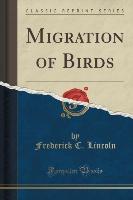Migration of Birds (Classic Reprint)
BücherAngebote / Angebote:
Excerpt from Migration of BirdsThroughout the ages the return ¿ights of migratory birds have been important as a source of food after a lean winter and as the harbinger of a change in season. The arrival of certain species has been heralded with appropriate ceremonies in many lands, and among the Eskimos and other tribes the phenomenon to this day is the accepted sign of the imminence of spring and of warmer weather. The pioneer fur traders in Alaska and Canada offered rewards to the Indian or Eskimo who saw the first goose of the spring, and all joined in jubilant welcome to the newcomer.As the North American Continent became more thickly settled, the large ¿ocks of ducks and geese that always had been hunted for food became objects of the enthusiastic attention of an increasing army of sportsmen. Most of the nongame species were found to be valuable also as allies of the farmer in his never-ending warfare against weed and insect pests. The need for laws protecting the valuable game and nongame birds and for regulating the hunting of the diminishing game species followed as a natural course. In the management of this wild life resource it has become obvious that continuous studies must be made of the food habits of the various species, their environmental needs, and their travels. Hence bird investigations are made by the Fish and Wildlife Service, the bureau charged by Congress under the Migratory Bird Treaty Act with the duty of protecting those species that in their yearly journeys pass back and forth between the United States and Canada, and between the United States and Mexico.For more than half a century the Fish and Wildlife Service and its predecessor, the Biological Survey, have been collecting data on the interesting and important phenomenon of the migration of North American birds. The field men of the Service have gathered informa tion concerning the distribution and seasonal movements of thedifferent species in many extended areas, from the Arctic coast south to the pampas of Argentina. Supplementing these investigations is the work of hundreds of volunteer ornithologists and bird students throughout the United States and Canada, who each year, spring and fall, forward to the Service reports on the migrations as observed in their respective localities. Added to the mass of data thus assembled is a rapidly growing recovery file of marked individuals. These data, together with other carded records gleaned by the Fish and Wildlife Service from a vast literature, constitute a series of files that now con tain well over entries, easily the greatest existing accumulation of information pertaining to the distribution and movements of North American birds. Not only do the facts thus assembled form the basis of regulatory action for the protection of the birds, but they also make it possible to publish scientific accounts of the ranges and migrations of the different species. They furnish the basis of this bulletin.About the PublisherForgotten Books publishes hundreds of thousands of rare and classic books. Find more at www.forgottenbooks.comThis book is a reproduction of an important historical work. Forgotten Books uses state-of-the-art technology to digitally reconstruct the work, preserving the original format whilst repairing imperfections present in the aged copy. In rare cases, an imperfection in the original, such as a blemish or missing page, may be replicated in our edition. We do, however, repair the vast majority of imperfections successfully, any imperfections that remain are intentionally left to preserve the state of such historical works.
Folgt in ca. 5 Arbeitstagen




